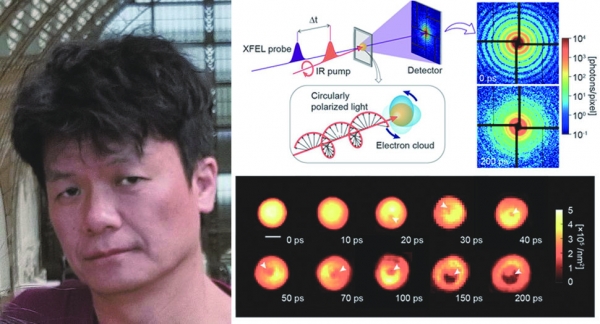
A research team of Professor Song Chang-yong (PHYS), Hwang Jun-ha (PHYS Integrated Ph. D Candidate), and Associate Prof. Ihm Yeong-ok (CHEM) observed a unique phenomenon occurring during the ultrafast photoinduced melting process and laid the groundwork for understanding ultrafast melting. The research was published online in the international journal Science Advances.
The melting phenomenon is one of the most common phase transitions. However, when it occurs in an extremely short time, it exhibits new characteristics. Applying an intense ultrafast laser to a material induces an “ultrafast photoinduced melting phenomenon,” in which melting occurs within picoseconds (ps, 10-12 seconds). The laser energy is mainly absorbed by electrons, and it occurs under a strong nonequilibrium state between electrons and ions. To understand this, it is essential to grasp the dynamic changes caused by the rapid energy transfer.
In the study, they used “Sinlge-pulse Time-resolved Coherent Diffraction Imaging” with the Pohang Accelerator Laboratory X-ray Free Electron Laser (PAL-XFEL) to directly observe the ultrafast photoinduced nonequilibrium melting process. The single-shot femtosecond (fs, 10-15 seconds) XFEL imaging is used to observe transient phases of target material irradiated by fs-infrared (IR) intervals to track internal structure changes. The fs-IR laser induces ultrafast melting of the material, and structural information is obtained from the diffraction signals generated by X-ray.
They visualized the internal density distribution of gold (Au) nanoparticles during melting and analyzed the results with two-temperature molecular dynamic simulations. Furthermore, they revealed that ions, which received energy from photo-activated electrons, created strong gigapascal (GPa) pressures over picoseconds, thus controlling the melting process.
The team also confirmed that ultrafast nonequilibrium melting involves an “inverted nucleation,” where voids inside the material grow like nuclei. This is unique to extreme conditions and not seen in typical melting. Additionally, they found that the polarization and intensity of the laser control the space changes. The polarization controls the location of void creation, and the intensity determines the distribution of the void creation.
“We have directly observed and interpreted the ‘inverted nucleation’ occurring in photoinduced nonequilibrium melting phenomenon,” said Prof. Song. He added, “The result will contribute to building up the foundation in understanding the phenomenon.”


